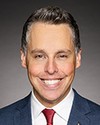Good afternoon, everyone.
Good afternoon, distinguished members of the committee.
As vice‑president of operations and business development for Propair Inc. and Edgard Co‑Chartering Platform, I'm honoured to have the opportunity to appear before you as part of this meeting. Thank you for inviting me.
Founded in 1954, Propair Inc. has the distinction as the oldest company of its kind, enjoying a predominant position in the specialized air charter and aeromedical transport industry in Quebec for several generations. Based in Rouyn‑Noranda, in Abitibi‑Témiscamingue, the company operates 12 turboprop aircraft, including four ambulance aircraft, to serve communities in northern Quebec, 24 hours a day, seven days a week.
Our organization's success is based on dedicated professionals with superior expertise and a culture that fosters the development of regional aviation. Despite this, Propair Inc., like all players in the airline industry, faces many challenges and obstacles. These include a growing shortage of qualified professional pilots, unstable weather conditions on gravel airstrips, and limited facilities and equipment, to name but a few.
Is it normal to head to a northern community to save a life and not know whether the runway is cleared properly, not know what the weather conditions are and not have access to de‑icing equipment? These challenges must be addressed in a context where our activities are carried out 24 hours a day, and their impact on the stress level of the crews and, by extension, on the level of risk to transportation safety must be considered.
I would have liked the witnesses in the first panel to hear my speech today.
To reduce operational risk and improve essential services to Canada's remote communities, we need a commitment from government institutions to invest in improvements to airport equipment and air navigation systems, as well as meteorological services.
I can't help but refer to the latest Canadian aviation regulations on flight crew hours of work. These regulations are intended to reduce the risk, but they also significantly reduce the experience in the cockpit.
Yes, the labour challenge is a concern and is hindering the growth of organizations like ours that want to train more pilots and increase the frequency of regional and rural air services. Transport Canada made these regulations mandatory, without consulting us and without taking into consideration the operational realities of regional carriers. In addition, these regulations have required us to increase our workforce by 35% just to maintain our operations. It's difficult for us, as well as a number of other airlines, to understand Transport Canada's reasoning in this matter.
While the above points raise major concerns for our industry, I'm confident that they are being studied carefully and that we're all working to improve the accessibility and strengthening of air services. We all want to encourage economic development in northern communities.
For information, starting up a new air link connecting a major city to a rural community with an 18‑seat plane, at a frequency of five days a week and with three hours of flight per day, represents a financial risk of several million dollars.
This is a risk we would be willing to take, along with our federal and provincial governments, if a grant program were put in place to offset the losses associated with starting a new link. This would allow us to offer travellers a better rate.
Although the creation of new commercial airlines in remote areas is good for the economic development of those regions, there are other ways to improve air service, without even hiring more pilots or buying more planes.
It's in this spirit of solutions, and with the objective of improving access to the regions, that my partner Étienne Lambert and I came up with the innovative idea of creating a co‑chartering platform, which we named Edgard.
Our mission is to make chartered air travel accessible to more travellers in a safe and reliable manner, and to provide more options for travellers, primarily in Canada's northern, rural and remote communities.
In order to comply with current regulations, co‑charter seats available on our platform are offered only to companies and their employees. This approach respects charter operators, carriers, and co‑charters, while maintaining the benefits of charter flights.
Many large corporations, both private and public, need and use charter flights to move their employees. These flights are generally between major cities and remote communities in Canada. While 100% flight capacity would be ideal, it's virtually impossible for these companies to have a perfect ratio between the number of employees who need to travel, aircraft capacity and flight frequency, which means that seats remain vacant and unused.
As I mentioned earlier, the current model isn't available to all travellers, but only to companies and their employees. However, it would be possible, in collaboration with government bodies, to relax certain air passenger protection regulations and make these seats available to all travellers, without restrictions.
The main reason for chartering an aircraft is to have total control over the aircraft, schedules and routes. It's therefore unrealistic to imagine a company and its carrier offering its vacant seats to the public if they run the risk of having to compensate passengers if they exercise their right to reroute a flight to meet their own charter needs.
It's only by optimizing chartered flights that major companies, along with their partner carrier, will be able to improve accessibility to Canada's northern, rural and remote communities.
I would add that, in such a case, seat pricing should be done in co‑operation with commercial airlines to avoid unfair competition and to respect each other's operational realities.
In conclusion, my colleagues and I believe that everyone should be free to enter into a contract on terms and conditions that they consider satisfactory, especially if it promotes the accessibility and democratization of regional flights. In that sense, we're convinced that this bill can make a big difference.
On behalf of myself and Propair Inc. and its Edgard app, thank you for the opportunity to share some of our realities we face and our vision.
I can tell you that we've made a strong commitment to regulation and to working with the various players in the industry.






